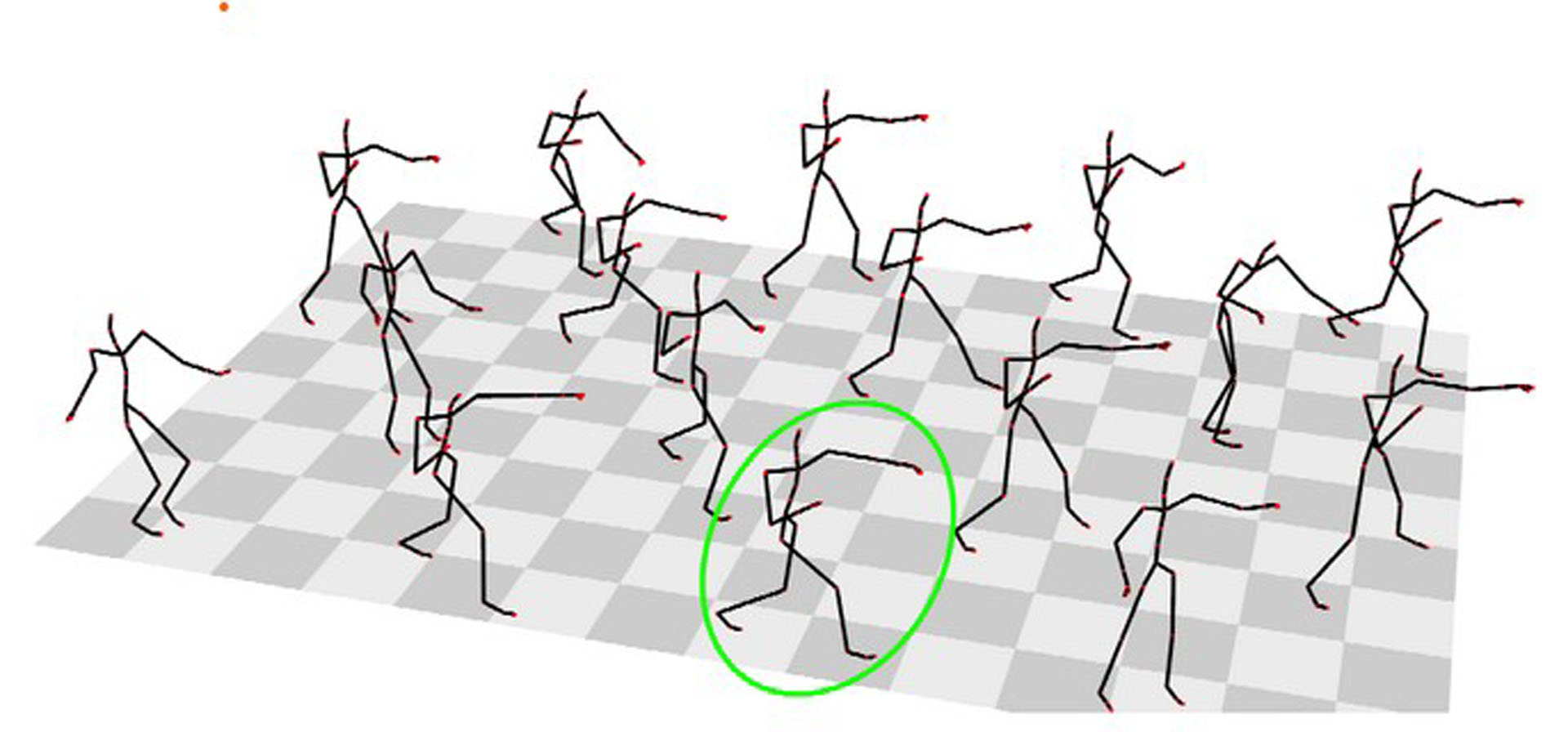“Efficient content-based retrieval of motion capture data” by Müller, Röder and Clausen
Conference:
Type(s):
Title:
- Efficient content-based retrieval of motion capture data
Presenter(s)/Author(s):
Abstract:
The reuse of human motion capture data to create new, realistic motions by applying morphing and blending techniques has become an important issue in computer animation. This requires the identification and extraction of logically related motions scattered within some data set. Such content-based retrieval of motion capture data, which is the topic of this paper, constitutes a difficult and time-consuming problem due to significant spatio-temporal variations between logically related motions. In our approach, we introduce various kinds of qualitative features describing geometric relations between specified body points of a pose and show how these features induce a time segmentation of motion capture data streams. By incorporating spatio-temporal invariance into the geometric features and adaptive segments, we are able to adopt efficient indexing methods allowing for flexible and efficient content-based retrieval and browsing in huge motion capture databases. Furthermore, we obtain an efficient preprocessing method substantially accelerating the cost-intensive classical dynamic time warping techniques for the time alignment of logically similar motion data streams. We present experimental results on a test data set of more than one million frames, corresponding to 180 minutes of motion. The linearity of our indexing algorithms guarantees the scalability of our results to much larger data sets.
References:
1. Bakker, E. M., Huang, T. S., Lew, M. S., Sebe, N., and Zhou, X. S., Eds. 2003. Proc. 2nd Intl. Conf. Image and Video Retrieval, CIVR 2003, Urbana-Champaign, IL, USA, vol. 2728 of LNCS, Springer.]] Google ScholarDigital Library
2. Bruderlin, A., and Williams, L. 1995. Motion signal processing. In Proc. ACM SIGGRAPH 95, ACM Press / ACM SIGGRAPH, Computer Graphics Proc., Annual Conf. Series, 97–104.]] Google ScholarDigital Library
3. Cardle, M., Vlachos, S. B., Keogh, E., and Gunopulos, D. 2003. Fast motion capture matching with replicated motion editing. ACM SIGGRAPH 2003. Sketches and Applications.]]Google Scholar
4. Carlsson, S. 1996. Combinatorial geometry for shape representation and indexing. In Object Representation in Computer Vision, 53–78.]] Google ScholarDigital Library
5. Carlsson, S. 1999. Order structure, correspondence, and shape based categories. In Shape, Contour and Grouping in Computer Vision, Springer, 58–71.]] Google ScholarDigital Library
6. Clausen, M., and Kurth, F. 2004. A unified approach to content-based and fault tolerant music recognition. IEEE Transactions on Multimedia 6, 5, 717–731.]] Google ScholarDigital Library
7. Cmu, 2003. Carnegie-Mellon MoCap Database. http://mocap.cs.cmu.edu.]]Google Scholar
8. Giese, M., and Poggio, T. 2000. Morphable models for the analysis and synthesis of complex motion patterns. IJCV 38, 1, 59–73.]] Google ScholarDigital Library
9. Green, R., and Guan, L. 2004. Quantifying and recognizing human movement patterns from monocular video images: Part I. IEEE Transactions on Circuits and Systems for Video Technology 14, 2 (February), 179–190.]] Google ScholarDigital Library
10. Keogh, E. J., Palpanas, T., Zordan, V. B., Gunopulos, D., and Cardle, M. 2004. Indexing large human-motion databases. In Proc. 30th VLDB Conf., Toronto, 780–791.]] Google ScholarDigital Library
11. Keogh, E. 2002. Exact indexing of dynamic time warping. In Proc. 28th VLDB Conf., Hong Kong, 406–417.]] Google ScholarDigital Library
12. Kovar, L., and Gleicher, M. 2003. Flexible automatic motion blending with registration curves. In Proc. ACM SIGGRAPH 2003 / Eurographics Symposium on Computer Animation, Eurographics Association, 214–224.]] Google ScholarDigital Library
13. Kovar, L., and Gleicher, M. 2004. Automated extraction and parameterization of motions in large data sets. ACM Transactions on Graphics 23, 3, 559–568.]] Google ScholarDigital Library
14. Last, M., Kandel, A., and Bunke, H., Eds. 2004. Data Mining In Time Series Databases. World Scientific.]] Google ScholarDigital Library
15. Pullen, K., and Bregler, C. 2002. Motion capture assisted animation: Texturing and synthesis. ACM Transactions on Graphics, 501–508.]] Google ScholarDigital Library
16. Sullivan, J., and Carlsson, S. 2002. Recognizing and tracking human action. In ECCV ’02: Proc. 7th European Conf. on Computer Vision—Part 1, 629–644.]] Google ScholarDigital Library
17. Witkin, A., and Popovic, Z. 1995. Motion warping. In Proc. ACM SIGGRAPH 95, ACM Press / ACM SIGGRAPH, Computer Graphics Proc., Annual Conf. Series, 105–108.]] Google ScholarDigital Library
18. Witten, I. H., Moffat, A., and Bell, T. C. 1999. Managing Gigabytes. Morgan Kaufmann Publishers.]]Google Scholar
19. Wu, M.-Y., Chao, S., Yang, S., and Lin, H. 2003. Content-based retrieval for human motion data. In 16th IPPR Conf. on Computer Vision, Graphics and Image Processing, 605–612.]]Google Scholar




